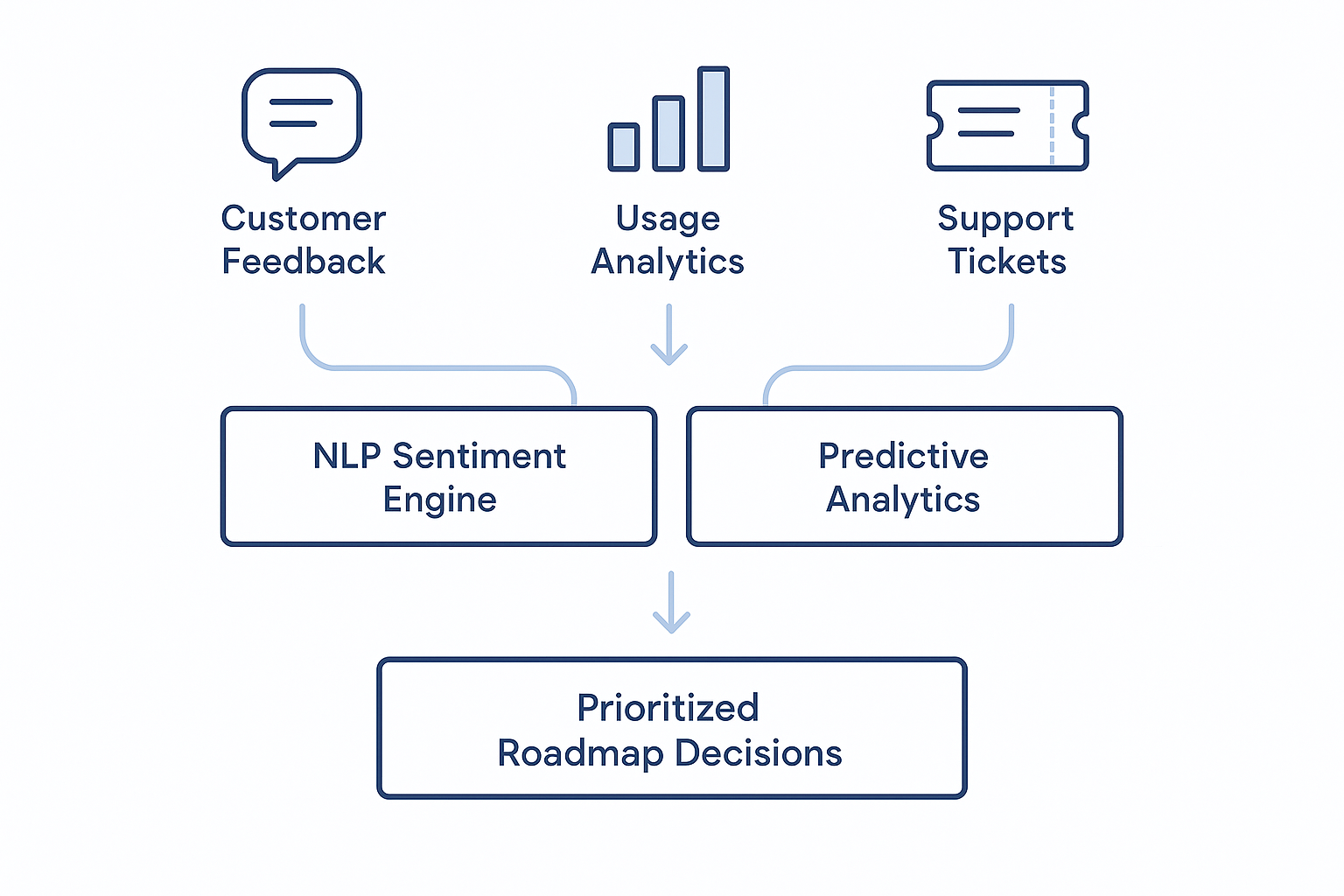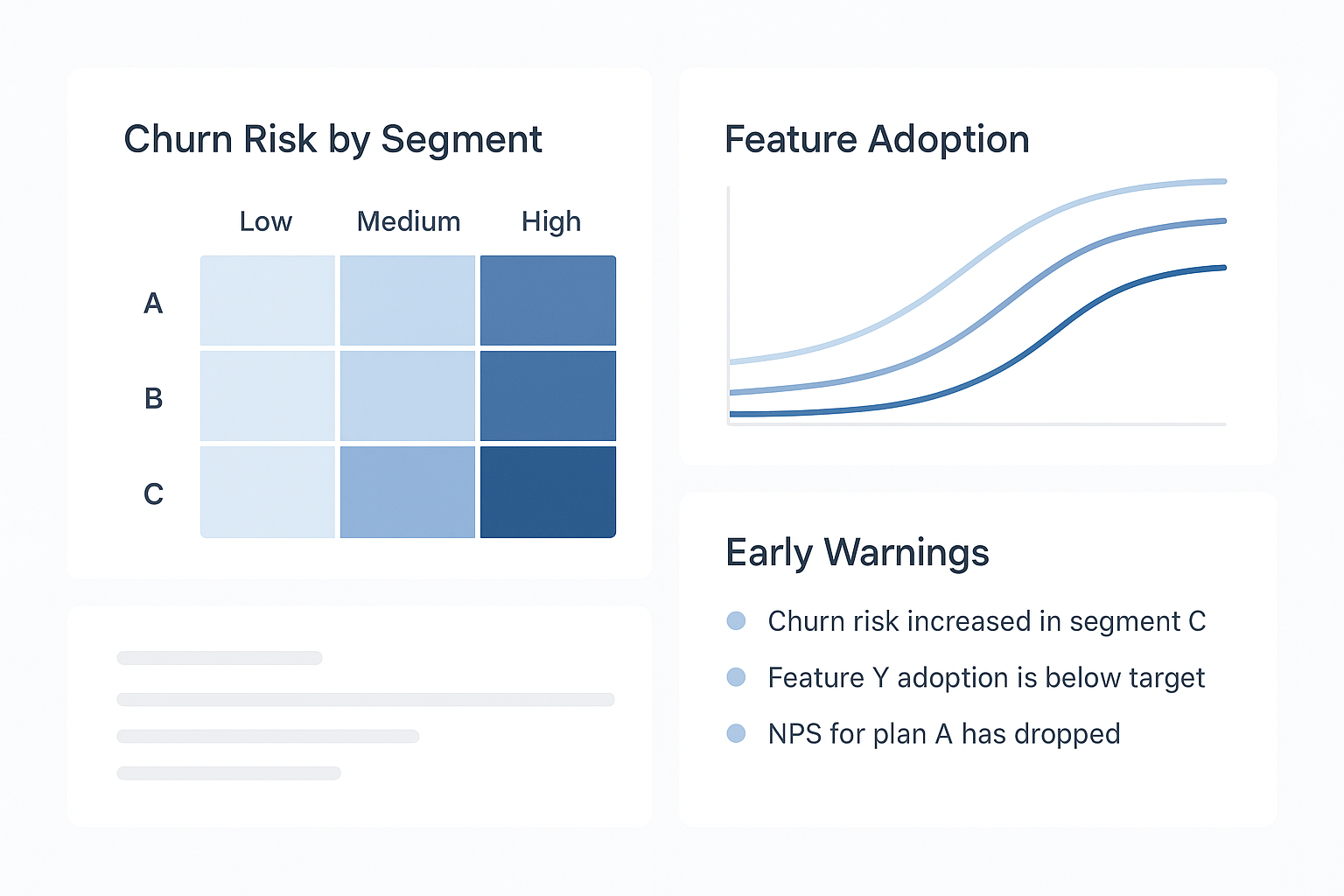# The quiet shift: from opinion to proof
AI in product management is not a trend, it is a discipline shift. We are moving from opinions and sporadic surveys to continuous, data-driven decision-making that still honors human judgment. Done well, AI compresses discovery time, spots weak signals early, and reduces routine work without flattening nuance.
Teams that adopt AI report sharper prioritization, faster iteration, and fewer blind spots. The craft is in choosing what to automate, what to predict, and where human sense-making stays in the loop.
# What AI actually adds to product judgment
AI extends attention. It processes feedback at scale, highlights patterns, and quantifies risk so decisions land faster and cleaner. This is not about replacing instincts. It is about validating them, or proving them wrong, with evidence.
- Natural language processing for feedback and support analysis
- Predictive analytics for demand, churn, and adoption
- Workflow automation for documentation and project signals
If you need a primer on where PMs are already applying AI, the overviews by Productboard and Effy are crisp and pragmatic: Productboard on AI for PMs (opens new window), Effy on AI use cases (opens new window).
# The AI decision loop, end to end
Good AI workflows look like tight feedback loops, not one-off models. Data in, sense-making, action out.

Inputs: customer feedback, usage analytics, support logs. Processing: sentiment, clustering, correlation, and prediction. Outputs: prioritized problems, forecasted impact, and clear next steps. When this loop runs continuously, small signals do not get lost.
Takeaway: Treat AI as a loop you can audit, not a black box you trust blindly.
# Real-time analytics without the noise
Periodic reports are slow. Real-time analytics, powered by AI, show change as it happens. That does not mean chasing every spike. It means:
- Alerts tied to material shifts, for example a 20 percent drop in onboarding completion by a key segment
- Context, not just numbers, for example the exact flows and events linked to the shift
- Suggested actions, for example move an experiment to the next sprint or trigger a customer success play
More on continuous product analytics here: AI-powered product analytics (opens new window).
# Predictive analytics that earns its keep
Prediction only helps if it changes a decision today. Focus on models that power actions you will actually take.

High-impact predictions for product teams:
- Churn risk by cohort, with leading indicators like declining weekly active days or feature usage depth
- Feature adoption curves, with expected time to activation and likely blockers
- Customer lifetime value by segment, to balance build vs. buy and support investments
Useful primers on behavior modeling: FullStory on predicting behavior (opens new window), Pragmatic Coders on modeling techniques (opens new window).
Principle: If you would not act differently at a given threshold, do not track it.
# Feedback analysis and sentiment, at scale
Feedback is gold, but panning for it takes time. With AI you can triage 10,000 comments, slice by topic, and isolate pain with context.
- Auto-tag themes like pricing confusion, import errors, or missing SSO
- Score sentiment and urgency, surface the top 5 issues inside an hour
- Link feedback to usage data, separate loud requests from high-value needs
If you want an integrated way to move from raw feedback to prioritized decisions, take a look at Sleekplan Intelligence (opens new window). It blends sentiment, impact estimation, and trend detection so product, engineering, and success work from the same source of truth.
# Automation that gives time back
Documentation and coordination can drain a week. AI can draft PRDs from discovery notes, update status summaries, and flag delivery risks based on velocity trends.
Practical wins we have seen:
- First-draft PRDs in minutes, final review still human
- Weekly rollups from support and NPS routed to the right owners
- Sprint risk alerts when scope creeps or cycle time slips by 15 percent
For broader context on AI agents in product ops, see Productboard’s write-up on AI agents in product operations (opens new window).
# How to implement AI in your product practice
Start small, measure hard, scale what works.
- Pick a concrete use case
- Automated feedback triage for one major channel
- Churn prediction for a single segment
- PRD drafting for one squad
- Define success upfront
- Time saved per week
- Lead time from insight to action
- Retention lift for the target segment
- Build the data basics
- Clean event tracking for activation and core actions
- Clear customer IDs across tools
- A lightweight warehouse or lake you can query
Helpful overview for first steps and change management: AI for product managers (opens new window).
# Team, governance, and ethics
AI is probabilistic, so guardrails matter. Set ownership and review rhythms.
- Data quality owner, with a simple schema and audits
- Model review cadence, test on recent cohorts, not just last quarter
- Bias checks for sensitive attributes, document known limits
On the ethics and governance side, Dataversity’s guide is practical: AI ethics and innovation for product development (opens new window).
Operating rule: Human judgment stays accountable. Let AI inform, do not let it decide in isolation.
# Measuring ROI without hand-waving
Capture baselines before you switch anything on. Then compare against the same clocks and counters.
- Routine work reduction, for example hours saved on triage and reporting
- Decision speed, for example time from signal to shipped fix
- Accuracy, for example churn model precision at the intervention threshold
- Outcome, for example activation rate or NPS change for targeted cohorts
Treat ROI as a portfolio. Some benefits are direct time savings, others are improved bets that pay off over months.
# Common questions, quick answers
- What is AI in product management? The use of machine learning and NLP to turn data into insights, predictions, and workflow automation that improve product decisions.
- Where should I start? Pick one narrow use case with clear metrics, then iterate.
- Will AI replace PMs? No. It upgrades the surface area of your attention so you can spend more time on strategy, clarity, and stakeholder alignment.
- How do I avoid bias? Use representative data, audit outputs regularly, and document constraints.
# The craft still matters
Tools accelerate you in the direction you already set. Clear problem definitions, crisp writing, and responsible ownership still separate strong teams from average ones. AI multiplies good practice. It also amplifies sloppiness. Choose carefully what you automate, keep your loops tight, and measure what you change.